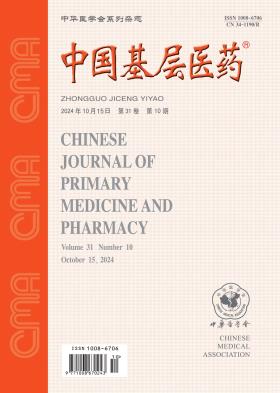Effects of PA and γ-glutamyltranspeptidase on hyperbilirubinemia in neonates
引用次数: 0
Abstract
Objective To explore the clinical significance of prealbumin(PA) and γ-glutamyltranspeptidase (γ-GT) detection in evaluation of hyperbilirubinemia in neonates at different stages. Methods From August 2017 to August 2018, 300 full-term delivery patients with neonatal hyperbilirubinemia were selected, including 210 early-stage neonates and 90 late-stage neonates.According to the severity of bilirubinemia, the patients were classified into mild group (50 cases), moderate group (150 cases), and severe group (100 cases). The blood levels of PA and γ-GT of each group were detected. Results The levels of PA and γ-GT in late neonates were (95.81±4.58)mg/L, (44.97±5.21)IU/L, respectively, which were significantly higher than those in early neonates [(94.77±6.32)mg/L, (53.88±6.32)IU/L](t=1.410, 11.767, P=0.160, 0.000). With the increase of bilirubin level, the blood PA level was gradually decreased(P<0.05). The blood γ-GT level of moderate and severe patients were significantly higher than that of mild ones (t=2.222, 2.020, P=0.027, 0.046). The blood levels of γ-GT and PA had no statistically significant differences between moderate patients and severe patients (t=0.712, 1.741; P=0.477, 0.083). The blood PA level of moderate and severe patients were significantly lower than that of mild patients (t=2.357, 3.277, P=0.019, 0.001). The serum PA levels had no statistically significant difference between severe patients and moderate patients (t=0.719, P=0.474); and the serum PA levels of severe and moderate patients were lower than that of mild patients (t=3.234, 2.117, P=0.001, 0.043). The serum γ-GT levels among the three groups had no statistically significant differences (severe vs.moderate: t=0.297, P=0.767; severe vs.mild: t=0.269, P=0.788; moderate vs.mild: t=0.013, P=0.989). Conclusion By detecting the levels of PA and γ-GT in neonatal hyperbilirubinemia in different periods, it can provide a reference for clinical judgment of the condition of the children, thus guiding clinical rational treatment. Key words: Prealbumin; γ-glutamyltranspeptidase; Hyperbilirubinemia; Neonatal; Diagnostic value; Full term; BilirubinPA和γ-谷氨酰转肽酶对新生儿高胆红素血症的影响
目的探讨前白蛋白(PA)和γ-谷氨酰转肽酶(γ-GT)检测在评价不同阶段新生儿高胆红素血症中的临床意义。方法选择2017年8月至2018年8月足月分娩的新生儿高胆红素血症患者300例,其中早期新生儿210例,晚期新生儿90例。根据胆红素血症的严重程度,将患者分为轻度组(50例)、中度组(150例)和重度组(100例)。γ-GT水平。结果晚期新生儿PA和γ-GT水平分别为(95.81±4.58)mg/L和(44.97±5.21)IU/L,显著高于早期新生儿[(94.77±6.32)mg/L和[(53.88±6.32,血PA水平逐渐下降(P<0.05),中、重度患者血γ-GT水平显著高于轻度患者(t=2.222,2.020,P=0.027,0.046),中重度患者血β-GT和PA水平无统计学差异(t=0.712,1.741;P=0.477,0.083)显著低于轻症患者(t=2.357,3.277,P=0.019,0.001)。重症患者和中度患者的血清PA水平无统计学意义(t=0.719,P=0.074);三组间血清γ-GT水平无统计学意义(重型组与中度组:t=0.297,P=0.767;重型组与轻度组:t=0.219,P=0.788;中度组与轻度对照组:t=0.013,P=0.989)高胆红素血症在不同时期,可为临床判断患儿病情提供参考,从而指导临床合理治疗。关键词:前白蛋白;γ-谷氨酰转肽酶;高胆红素血症;新生儿;诊断价值;全日制;胆红素
本文章由计算机程序翻译,如有差异,请以英文原文为准。
求助全文
约1分钟内获得全文
求助全文
来源期刊
CiteScore
0.10
自引率
0.00%
发文量
32251
期刊介绍:
Since its inception, the journal "Chinese Primary Medicine" has adhered to the development strategy of "based in China, serving the grassroots, and facing the world" as its publishing concept, reporting a large amount of the latest medical information at home and abroad, prospering the academic field of primary medicine, and is praised by readers as a medical encyclopedia that updates knowledge. It is a core journal in China's medical and health field, and its influence index (CI) ranks Q2 in China's academic journals in 2022. It was included in the American Chemical Abstracts in 2008, the World Health Organization Western Pacific Regional Medical Index (WPRIM) in 2009, and the Japan Science and Technology Agency Database (JST) and Scopus Database in 2018, and was included in the Wanfang Data-China Digital Journal Group and the China Academic Journal Comprehensive Evaluation Database.

 求助内容:
求助内容: 应助结果提醒方式:
应助结果提醒方式:


